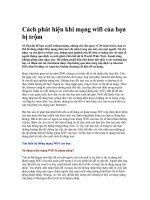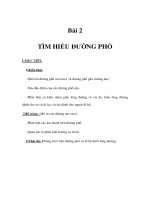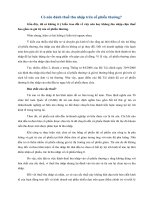Tài liệu Weld Symbol - Kí hiệu đường hàn trên bản vẽ KT ppt
Bạn đang xem bản rút gọn của tài liệu. Xem và tải ngay bản đầy đủ của tài liệu tại đây (1.38 MB, 16 trang )
ldhuan\loptvgs\KCT\C3-lienkethan (Feb.05)
1
Deciphering Weld Symbols
When welds are specified on engineering and fabrication drawings, a cryptic set of symbols is
used as a sort of shorthand for describing the type of weld, its size, and other processing and
finishing information. The purpose of this page is to introduce you to the common symbols and
their meaning. The complete set of symbols is given in a standard published by the American
National Standards Institute and the American Welding Society:
ANSI / AWS A2.4, Symbols for Welding and Nondestructive Testing.
Our thanks to Dr. Kent L. Johnson, past Chairman of the AWS Chicago Section, for his many
helpful comments on the content of our welding pages.
The structure of the welding symbol
The horizontal line--called the reference line--is the anchor to which all the other welding
symbols are tied. The instructions for making the weld are strung along the reference line. An
arrow connects the reference line to the joint that is to be welded. In the example above, the arrow
is shown growing out of the right end of the reference line and heading down and to the right, but
many other combinations are allowed.
Quite often, there are two sides to the joint to which the arrow points, and therefore two potential
places for a weld. For example, when two steel plates are joined together into a T shape, welding
may be done on either side of the stem of the T.
The weld symbol distinguishes between the two sides of a joint by using the arrow and the spaces
above and below the reference line. The side of the joint to which the arrow points is known
(rather prosaically) as the arrow side, and its weld is made according to the instructions given
ldhuan\loptvgs\KCT\C3-lienkethan (Feb.05)
2
below the reference line. The other side of the joint is known (even more prosaically) as the other
side, and its weld is made according to the instructions given above the reference line. The
below=arrow and above=other rules apply regardless of the arrow's direction.
The flag growing out of the junction of the reference line and the arrow is present if the weld is to
be made in the field during erection of the structure. A weld symbol without a flag indicates that
the weld is to be made in the shop. In older drawings, a field weld may be denoted by a filled
black circle at the junction between the arrow and the reference line.
The open circle at the arrow/reference line junction is present if the weld is to go all around the
joint, as in the example below.
The tail of the weld symbol is the place for supplementary information on the weld. It may
contain a reference to the welding process, the electrode, a detail drawing, any information that
aids in the making of the weld that does not have its own special place on the symbol.
Types of welds and their symbols
Each type of weld has its own basic symbol, which is typically placed near the center of the
reference line (and above or below it, depending on which side of the joint it's on). The symbol is
a small drawing that can usually be interpreted as a simplified cross-section of the weld. In the
descriptions below, the symbol is shown in both its arrow-side and other-side positions.
Fillet Welds
The fillet weld (pronounced "FILL-it," not "fil-LAY") is used to make lap joints, corner joints,
and T joints. As its symbol suggests, the fillet weld is roughly triangular in cross-section, although
its shape is not always a right triangle or an isosceles triangle. Weld metal is deposited in a corner
formed by the fit-up of the two members and penetrates and fuses with the base metal to form the
joint. (Note: for the sake of graphical clarity, the drawings below do not show the penetration of
the weld metal. Recognize, however, that the degree of penetration is important in determining the
quality of the weld.)
ldhuan\loptvgs\KCT\C3-lienkethan (Feb.05)
3
The perpendicular leg of the triangle is always drawn on the left side of the symbol, regardless of
the orientation of the weld itself. The leg size is written to the left of the weld symbol. If the two
legs of the weld are to be the same size, only one dimension is given; if the weld is to have
unequal legs (much less common than the equal-legged weld), both dimensions are given and
there is an indication on the drawing as to which leg is longer.
The length of the weld is given to the right of the symbol.
If no length is given, then the weld is to be placed between specified dimension lines (if given) or
between those points where an abrupt change in the weld direction would occur (like at the end of
the plates in the example above).
ldhuan\loptvgs\KCT\C3-lienkethan (Feb.05)
4
For intermittent welds, the length of each portion of the weld and the spacing of the welds are
separated by a dash (length first, spacing second) and placed to the right of the fillet weld symbol.
Notice that the spacing, or pitch, is not the clear space between the welds, but the center-to-center
(or end-to-end) distance.
For more information, see ANSI/AWS A2.4, Symbols for Welding and Nondestructive Testing.
Groove Welds
The groove weld is commonly used to make edge-to-edge joints, although it is also often used in
corner joints, T joints, and joints between curved and flat pieces. As suggested by the variety of
groove weld symbols, there are many ways to make a groove weld, the differences depending
primarily on the geometry of the parts to be joined and the preparation of their edges. Weld metal
is deposited within the groove and penetrates and fuses with the base metal to form the joint.
(Note: for the sake of graphical clarity, the drawings below generally do not show the penetration
of the weld metal. Recognize, however, that the degree of penetration is important in determining
the quality of the weld.)
The various types of groove weld are:
The square groove weld, in which the "groove" is created by either a tight fit or a slight
separation of the edges. The amount of separation, if any, is given on the weld symbol.
ldhuan\loptvgs\KCT\C3-lienkethan (Feb.05)
5
The V-groove weld, in which the edges of both pieces are chamfered, either singly or doubly, to
create the groove. The angle of the V is given on the weld symbol, as is the separation at the root
(if any).
If the depth of the V is not the full thickness--or half the thickness in the case of a double V--the
depth is given to the left of the weld symbol.
If the penetration of the weld is to be greater than the depth of the groove, the depth of the
effective throat is given in parentheses after the depth of the V.
ldhuan\loptvgs\KCT\C3-lienkethan (Feb.05)
6
The bevel groove weld, in which the edge of one of the pieces is chamfered and the other is left
square. The bevel symbol's perpendicular line is always drawn on the left side, regardless of the
orientation of the weld itself. The arrow points toward the piece that is to be chamfered. This extra
significance is emphasized by a break in the arrow line. (The break is not necessary if the designer
has no preference as to which piece gets the edge treatment or if the piece to receive the treatment
should be obvious to a qualified welder.) Angle and depth of edge treatment, effective throat, and
separation at the root are described using the methods discussed in the V-groove
section.
The U-groove weld, in which the edges of both pieces are given a concave treatment. Depth of
edge treatment, effective throat, and separation at the root are described using the methods
discussed in the V-groove
section.
The J-groove weld, in which the edge of one of the pieces is given a concave treatment and the
other is left square. It is to the U-groove weld what the bevel groove weld is to the V-groove









